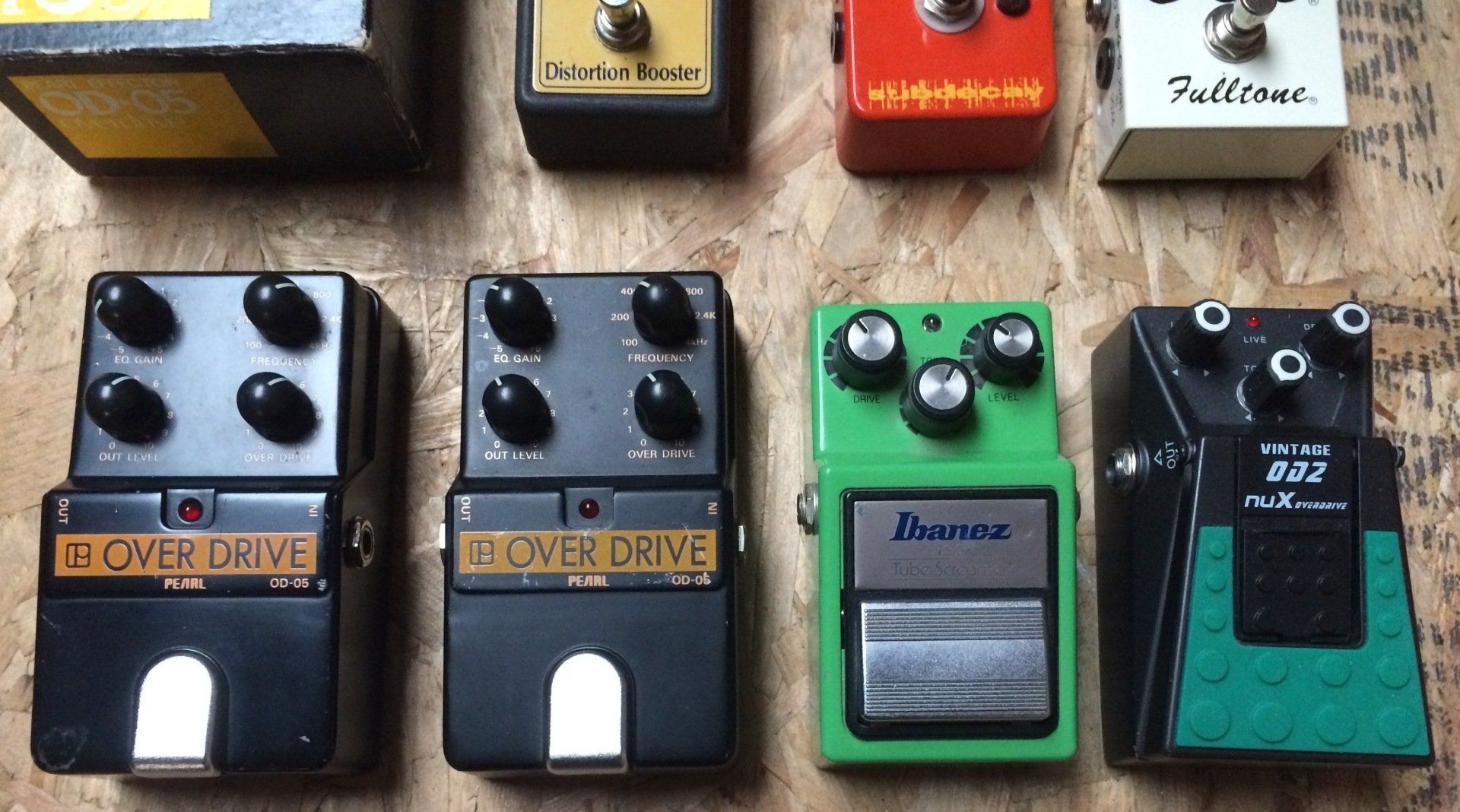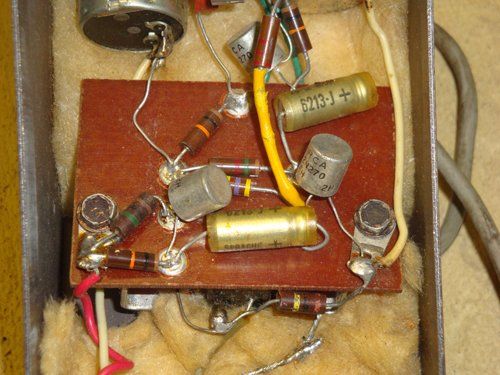Fuzzy Recollections…
… dishing the dirt on distorted guitar.
Why are there so many fuzz boxes out there? I suppose one might as well ask why there are so many varieties of hot sauce. I’m writing this in Sacramento, whilst on tour, and the range of hot sauces I can buy in this small city is quite dizzying. Everybody likes a little pep, but everyone has different tastes; and people’s tastes change of course, not only from day to day but over their lifetimes. We all had a RAT in 1985 and while some of us still do or have even returned to a clone of it, it’s not what everyone would choose. One person loves the original MOSFET Fulltone Full-Drive, but the next person doesn’t see what all the fuss is about. Most guitarists will get two or three “dirt boxes” that they like for different jobs and some will buy dozens! And this seemingly endless variety is not just a matter of personal taste. We need to consider what comes in front of the pedal, and also what comes after it. Even if two players are using Strats the differences in pickups could be vast. And what about the amps they’re using? A trawl around online forums quickly reveals that guitarists are prone to disagreeing over the merits of fuzz boxes without making any kind of allowances for the vast differences in pickups and amps that each may be using. Thankfully, of course, there are also more informed opinions that acknowledge the importance of those differences as well. Pedal order is yet another factor: the differences that occur in your sound when you swap the order of the effects in your signal chain. It’s not just the ingredients you choose, it’s the order in which you combine and cook them, it’s the different levels of spice you can achieve. Indeed in the early 1980s Pearl, the well known drum manufacturer, put out a range of guitar pedals called the Sound Spice series. They are, by and large, a superb series of effects with their own distinct flavours (we have an OC-07 Octave and two OD-05 Over Drives here at New Cut Studios). Whilst the Pearl Over Drive has a similar topology to a Tube Screamer it has a parametric EQ prior to the clipping stage so that you can move that TS mid hump around or lose it altogether. Maybe I'm labouring the seasoning metaphor, but the point I’m trying to make, is that you have to think of your whole rig as your instrument. After all, Leo Fender originally considered an amp with electric guitar as a discrete instrument in his designs. But then, you don’t always need a guitar amp when you’re recording.
In 1961 Grady Martin plugged his 1956 model Danelectro baritone guitar straight into the desk for his part on Marty Robbins’ country-pop hit 'Don’t Worry', but there was a fault on the channel’s preamp, perhaps in a transformer, and the recording was wildly distorted. Supposedly Martin didn’t like the results but the producer certainly did and he kept the track. It was a hit and Grady must have changed his mind about fuzzy tones because he then used almost the very same riff on his own instrumental record. That track was actually called 'The Fuzz' and beat Marty Robbins’ record to release. It’s been said that he recorded it through the same dodgy channel. Lucky for him it hadn’t been repaired; well it sometimes takes us a while to get something like that fixed here at New Cut too. But what do you do for that sound when the mic-pre does get fixed? It was this very thought that led the engineer on that 'Don’t Worry' session, Glen Snoddy, to design what might be the very first guitar pedal. Snoddy has said that the transformer in the faulty valve preamp from the recording console later failed completely. So together with another engineer by the name of Revis Hobbs he worked out a transistor based circuit and put it in a box. I’ve no idea if this prototype was already in the form of a floor mounted foot-switch device, but that's certainly what it became after they took the idea to Gibson and the Maestro FZ-1 Fuzz Tone pedal was born. But the Maestro wasn’t the first fuzz-in-a-box. Because a year earlier Al Casey had already used a custom fuzz box in sessions for the Sanford Clark recording 'Go On Home' in 1960. The record was produced by the great Lee Hazelwood who’d already had a fuzz effect unit built for his studio by a radio station technician he knew. So just where did Hazelwood get the idea from?
The history of guitar distortion is fuzzy in itself and littered with claims and counter-claims as to who did what first, or intentionally, before anyone else ever tried it. But there’s nothing new under the sun. Did Dave Davies really “invent Heavy Metal” by damaging a speaker cone and riffing power chords on The Kinks’ 'You Really Got Me' in 1964? Well actually Link Wray had already done both of those things on 'Rumble' in 1958. I’ve read that the amplifier Wray modified was a 1953 Premier 71. These were made by Multivox, a manufacturing subsidiary of New York-based retailer/wholesaler the Peter Sorkin Music Company. The amp had one central 12" Jensen Field-Coil speaker but with two additional 3" Jensen tweeters in the top corners of the cabinet. Supposedly Link Wray only pierced holes in these 3” cones. Dave Davies’ dirt box was an Elpico AC55 “little green amp” like the one famously owned by Paul McCartney. Davies says he used a razor blade to cut radial slashes in it’s elliptical Celestion cone. Was a 19 year old Ike Turner the teenage father of Rock ’n’ Roll with his 1951 hymn to Oldsmobile’s 'Rocket 88'? For years it was claimed as the first ever Rock n’ Roll recording and it has what sounds like a deliberately distorted guitar — allegedly due to a speaker cone in a Fender Tweed amp being damaged by a fall from a car into the road in the rain.
But you didn’t need to damage your equipment to get distortion. In 1951 Howlin’ Wolf’s guitarist Willie Lee Johnson just cranked up a little amp to play distorted guitar on tracks like 'How Many More Years'. The Blues has always understood how to express emotion through strained voices, whatever the instrument. In recent years Goree Carter’s 1949 record 'Rock Awhile' has trumped 'Rocket 88' as the “genre first” in rock historians’ ears and it too has a distorted guitar, which sounds like an overdriven amp. Anyone who hears this record today cannot but think it was a huge influence on Chuck Berry’s playing style. In 1956 when the Johnny Burnette Trio reworked 'The Train Kept A-Rollin’ ' with a guitar riff it was deliberately distorted during recording (or so the anecdote goes) when Paul Burlison intentionally reproduced an accidental fuzz that had occurred once when a valve worked loose before a gig in Philadelphia (incidentally the clean guitar parts on 'Train…' were played by Grady Martin so he was no stranger to distorted guitar when the 'Don't Worry' session came around). This may have been one reason why the Yardbirds decided to cover 'The Train Kept A-Rollin’ ' in 1965. Many have claimed that Burlison’s was the first deliberate use of distortion in a recording session but as we’ve seen there were earlier recordings where people made choices about the sound they wanted to hear from the guitar. Indeed Junior Barnard achieved his “low down & dirty” sound by hard picking and overdriving his amp as far back as 1945 — so can we say he was the first guitarist to choose to play with distortion as a tonal decision?
Going back to separate effect devices designed to distort an audio signal: just when did the fuzzbox become a thing we couldn’t do without? The American instrumental band The Ventures got their friend Orville "Red" Rhodes to help them reproduce Grady Martin’s 'The Fuzz' sound. Rhodes was an electronics buff as well as being a session guy and with the fuzzbox he made The Ventures recorded '2000 Pound Bee' in 1962. That same year Gibson introduced the Maestro FZ-1, their production model of Snoddy & Hobbs’ germanium tranny design. It is reckoned to be the first commercially produced fuzzbox and there’s a photo of George Harrison with one at the sessions for 'She Loves You' in 1963. I can’t think of a Beatles song where Harrison used a fuzz sound that early on, in fact McCartney’s fuzz bass melody on George’s song 'Think For Yourself' may have been the first product of the Beatles using the Maestro in 1965. Many people have pointed to Keith Richards’s use of a Maestro on 'Satisfaction' as it’s first really notable use on a hit record. However, as mentioned in the previous paragraph, the Yardbirds were definitely listening to distorted riffs in 1965. Jeff Beck used a custom-built fuzz pedal (borrowed from a soon to be famous friend) on a recording even earlier than Keef’s seminal riff, which The Yardbirds released on the 4th of June 1965. As Tolinski & Di Perna relate in their excellent history of the electric guitar Play It Loud: “The fuzzbox that Beck used for the main riff on 'Heart Full Of Soul' was a device lent to him by his close friend Jimmy Page, a custom box designed and built by Roger Mayer, who would go on to create guitar effects devices for Jimi Hendrix, Bob Marley and many others. Beck’s use of fuzz on 'Heart Full Of Soul' predated Keith Richards’s prominent use of a Gibson FZ-1 fuzzbox on The Rolling Stones’s 'Satisfaction' by a little over a month. It is truly a landmark recording. For the song’s guitar solo, Beck opted to use another early fuzz pedal, a Sola Sound Tone Bender.” The history of the Tone Bender, the first UK production fuzz pedal introduced in 1965, is a fascinating story in it’s own right. There's a really good video on YouTube by That Pedal Show & JHS Pedals entitled Tone Bender Special With JHS Josh & Anthony Macari. The Jen Fuzz we have at New Cut Studios is a late '60s Vox variant of the Tone Bender. And then, the Dallas Fuzz Face, the Electro Harmonix Big Muff, the Shin-ei Super Fuzz, all followed in quick succession. We suddenly couldn’t do without them it seemed. Silicon transistors replaced germaniums, then FETs followed, which were then superseded by op-amps in their turn. The pedal industry was born.
We’ll probably never know who “invented” distorted guitar, but I would bet that even before George Beauchamp developed a magnetic pickup to amplify guitar strings, some six-string-shooter somewhere used a phonograph pick-up or telephone microphone amplified through a home radio receiver and was either delighted or disappointed with the distorted sound that resulted. So we might be able to push distorted guitar back earlier than the 1932 Rickenbacker Frying Pan pickup. Maybe even as far back as 1921 with the first paper coned speaker. Could it even go back as far as the 1904 invention of the thermionic valve or “vacuum tube” by John Ambrose Fleming? Who knows, but one thing we do know for sure, dirty guitar is here to stay and each generation will find their own flavours to spice things up. So whatever your preference for putting a little pep in your guitar sound, you can be certain at least that you’re following a long and illustrious tradition. I had intended to write a feature about all kinds of distorted guitar, and the development of different signal overdrive and clipping devices, but it’s taken me this long to cover just the origins of fuzz effects. It’s such a huge subject I think it’s going to take a few articles.
© Mark Vickers 19/09/2016, 27/3/2020.



